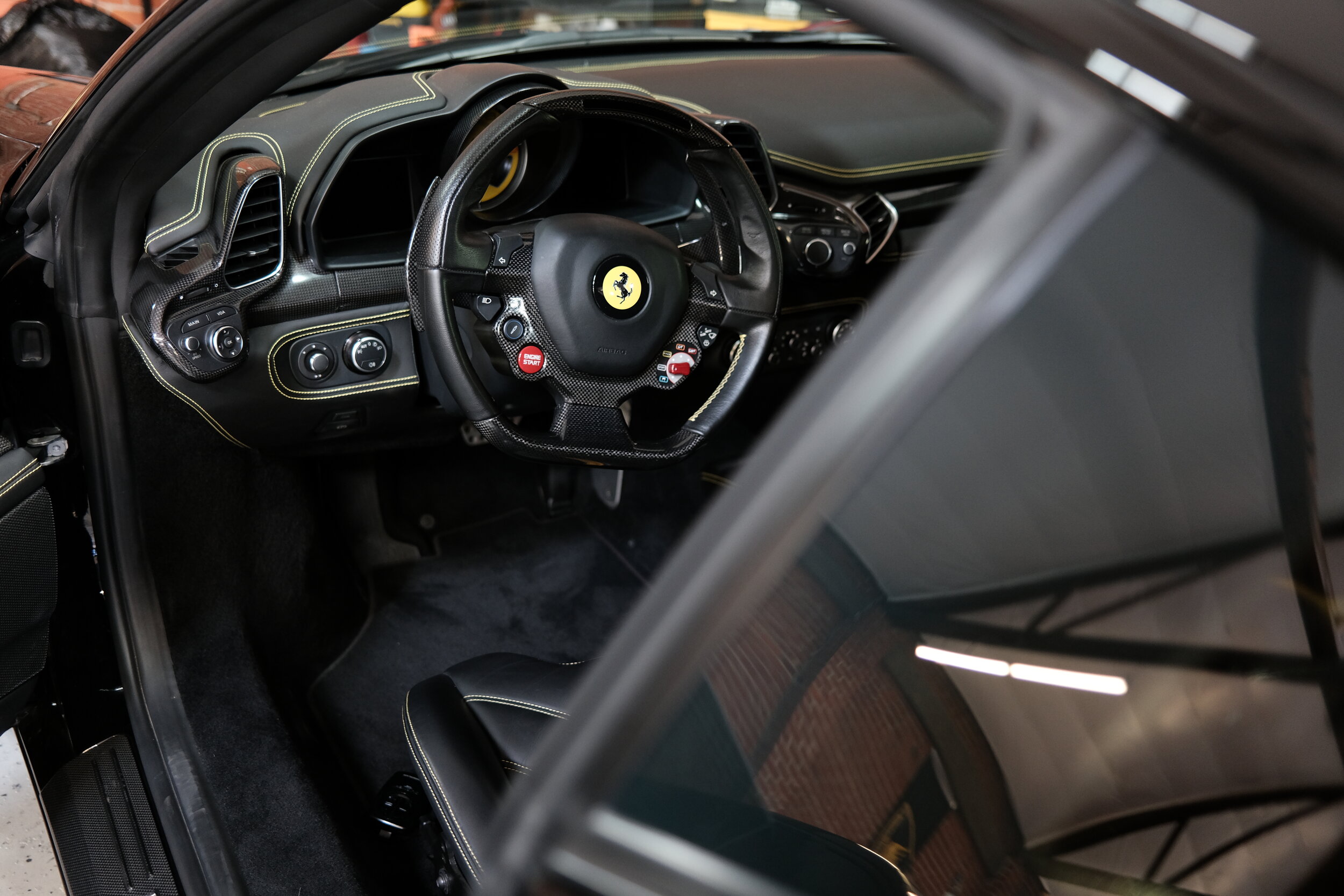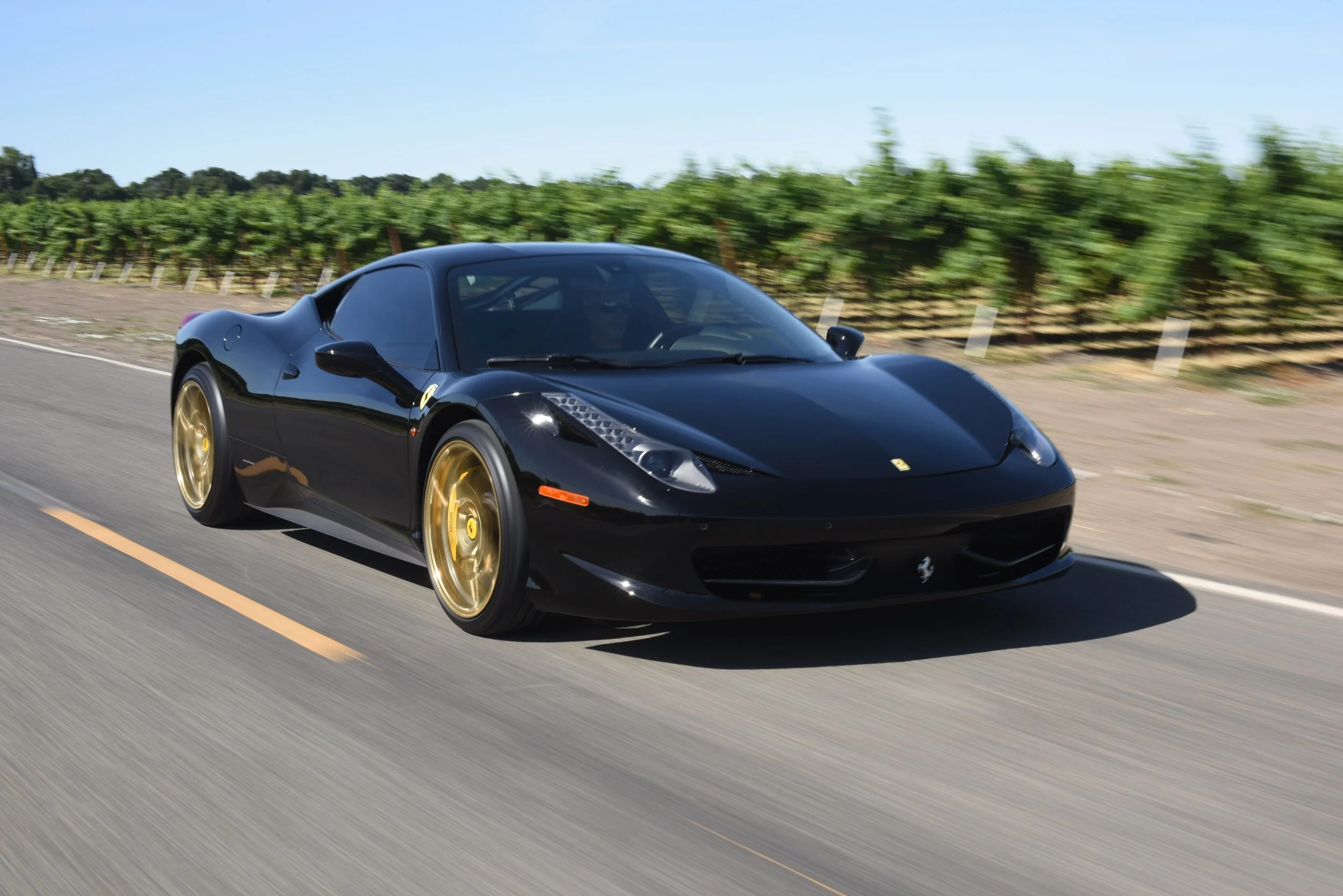The sweet spot, Ferrari 458 Italia
Mike Blanchard: Words-Photos
On a cool summer morning a sleek black Ferrari 458 Italia, a car that by all rights should be out tearing up the backroads at high speed right now, came burbling up through the Delta town of Freeport at the regulation speed limit of 35 MPH. It is kind of a slow-motion Bo Derek running-on-the-beach moment. It’s not to be wondered at, really, the Italia is one of the most sensuous of all automobile shapes: all hips and thighs. As it pulled into the parking lot for our photo shoot, the black paint reflected the surrounding landscape in wild surrealist visions. The thing could draw a crowd in the most jaded of settings.
Parked and turned off, the car ticking as it shed heat, Greg Wilson popped out of the driver’s side and couldn’t help a quick admiring glance at the car. It’s good to remember that it is just a car, really. And a work of art to be sure, but … The surprising thing is how competent an everyday car the 458 is. Counterintuitive for such a shameless, extravagant, speedy concoction. Like an Italian supermodel with an Olympic gold medal for boxing. There is nothing wrong with great beauty and real-world competence.
When the 458 debuted, it was a revelation. Widely regarded as one of the best sports cars ever made at any price, five years after its demise the 458 is still a very special car. Some of the development was done by Ferrari’s ace chauffeur, Michael Schumacher, with input on the steering wheel and interior as well as the handling.
Let’s face it, very few people who own an F-40, F-50, Enzo, La Ferrari, or something like a Bugatti or McLaren F-1 are going to drive the damn thing. They are worth multiple millions of dollars and are often way over the head of their owner. They’re as much investment or kinetic sculpture as car. The financial risk is so large driving these cars to their full potential that you have to be well-heeled indeed to tickle the accelerator with any brio.
No … no, you need a car that’s a little smaller and more user-friendly but with blinding speed and a price tag that makes you more willing to get it out and hammer it. The car for you is the Ferrari 458 Italia. The current retail runs $150,000 to $225,000. At that price you are not paying for vintage and you are not taking the depreciation on a new car. It’s the sweet spot of Ferraris.
The 458 was first shown in 2009 at the Frankfurt Motor Show and went on sale in 2010 as the replacement for the 430. Built until 2015, it was intended to be a step up from the entry-level California. It’s a literal and spiritual successor to the very successful 308 series of cars. But the 458 punched so far above its weight that it quickly became the standard against which other cars were judged.
“You can get bat-shit crazy in it and it’s enjoyable all the way around”
Wilson, who owns exotic car dealership Luxury Motorcars, has been driving a 458 almost every day for over a year. “It’s about as reliable as you can get in a supercar,” he says. “Once they went to the dual clutch it was a game-changer. I hate to use this kind of terminology, but it's like driving a Honda. You can drive it as easy as you want or you can get bat-shit crazy in it and it’s enjoyable all the way around.”
Matthew H-McCormick is a service manager at Stewart’s Automotive, a Sacramento shop specializing in performance cars. He has a great overview of Ferrari products and their service needs and peculiarities. “It’s rare to have any issues with a 458,” he says. “They just come in for routine service. It’s the most bulletproof Ferrari they have introduced. I have a customer who has over 100,000 miles on his. … He drives it every day.”
“It’s like a 911 from back in the day,” says Stewart Rosen, owner of Stewart’s Automotive. “It’s a car you can use every day. It’s not like a motorcycle you only ride on the weekend. Where you are like, ‘OK, I’m going to ride today.’ Where you need a state of mind to drive it.”
For an exotic car, services are relatively inexpensive (calm down; I said relatively). “They’re basically just oil changes, brakes and tires,” said Wilson. “The cars do need to be kept on a battery charger when not being driven regularly. They are susceptible to low-voltage issues.”
“A basic service is an oil change, brake flush and check-over, which runs $650 to $700,” says H-McCormick. “The brakes are carbon ceramic so they never wear out [Ed.: In fact, they will wear out, but they are remarkably long-lasting]. We’ve never done a brake job on one.” The other good thing about the 458 says H-McCormick, is that there are lots of used parts from wrecked cars. Guys get over their head and end up wrapping it around a tree.
I know you are thinking, “Jeez, $700 for a service!” Well, with cars like this the purchase price is just the cost of admission. And seven bills is cheap for an exotic car service … damn cheap. And you can’t go down to the AutoZone for some plugs or wires. They won’t work right.
Ferrari has worked to make the cars more user- and service-friendly. Customers just don’t like unreliability and stratospheric service charges. It's bad for the brand.
You can change the spark plugs with the engine in the car, which is not always the case with supercars. Older generations of Ferrari like a 355 need to have the engine out to be able to change the plugs or do a major service. As if Ferrari figured no one would ever need to service the overly finicky thing. With the 430, Ferrari went to a timing chain from cam belts, and this has made a big difference in the long-term reliability of the engine as well as eliminating the expensive cam-belt change.
The 458 Italia is powered by a 419 KW, 580 HP, 4.5 liter V-8 with a seven-speed Getrag paddle-shift transmission. Top speed is about 210 mph. The 458 introduced a technical first for Ferrari: Under the glass hood the naturally-aspirated engine is fitted with direct injection built by Magnetti Marelli. In this system, rather than having the fuel injectors spray into the intake runners the injectors are mounted in the head and spray directly into the combustion chamber. This is an extremely accurate and efficient way to control air-fuel mixture. It's technology taken directly from F-1 racing.
The 458 was designed by Donato Coco in conjunction with Pininfarina. The shape is notable for its clean lines and lack of wings. There are however, a set of front wings hidden in the front air intake that move to stabilize the car at high speed. It is also equipped with a rear diffuser and under tray ground effects that give it downforce.
There are the usual variations of the 458. There is a Spider, hard-top convertible, and a couple marques of performance variation as well as a race versions.
Behind the wheel you sit very low, as one does in a supercar, and you need to be careful getting in, but once in the carbon-fiber driver’s seat the position is very natural and comfortable. The seats are supportive, and despite a very lean, spare, racy look, they are comfortable. It is hard to go really fast if you are not comfortable.
“What I like about these cars in particular is everything is on the wheel,” says Wilson. “You don’t have to reach for anything. You have your lights. You have your suspension settings. …You have your map settings, you know, engine management. If you put it in wet and it’s raining, you can hammer the car like a Formula One car and it finds the grip and it just keeps you in check. Obviously you can turn everything off and get crazy.”
The 458 does not come with a stick-shift option. So there is none of the famed Ferrari polished shift-gate action. It is frankly a matter of survival for the clutch and transmission. The car has so much power that you could smoke the clutch in seconds if you got too squirrely with the dang thing.
The 458 is clever. If you do something stupid like forget to downshift, the car will do it for you. The traction settings will keep you from looping the thing pulling out of the parking lot. There is a suspension setting for rough roads that raises the ride height. Of course, you shift with the carbon-fiber paddles just in front of the steering wheel rim. There is no clutch pedal. You can drive the car in Automatic but … it’s hard on the clutches, and why?
When you pull away from a stop you can feel the massive reservoir of torque from the engine. It pulls hard. Way harder than your buddy’s 440 Dodge … or anything else you ever drove this side of a big sport bike.
There is no clutch pedal because you don’t need one. The gear-change mechanism shifts almost instantly as you touch the shifter. Without a lot of flywheel the engine spins up quick, and a flashing red light on the top of the steering wheel says “Hit the paddle, man.”
As you keep your foot in it your head says, “OK, this madness will stop any time now,” but the damn thing just keeps pulling and pulling, and the exhaust note growling and spitting and howling behind you. Like Mr. Toad, you just don’t give a damn, you are so taken with the beauty and mechanical amazement of this car. And then a Prius pulls out in front of you, and there you are toddling along at 35 MPH.
Driven like an everyday car it’s as smooth and easy as you want with the A/C blasting cold on a 100 degree-plus day. And the 458 is not overheating (one of the traditional issues with an Italian supercar).
The throttle is sensitive, and it is a little jerky and hard to modulate subtle throttle input. I imagine one could get used to it. The steering, two turns lock-to-lock, has none of the overly quick racecar feel. You can feel the road and what the front tires are doing through the wheel. It is a massive cliché, but driving a 458 you feel like you are part of the machine. Everything just comes to you like all the nerve impulses pouring into your brain.
There is a reason why the 458 is still regarded by those in the know as one of the best Ferraris ever made. It is about as perfect a mixture of speed, competence, reliability and beauty as exists. Even if they don’t make it anymore. And the exhaust note is just magic. The car comes with a stereo, but I’ll bet the farm that most owners just listen to the engine.
Does the world really need a 200 mph extravagance? Hell, yes, it does. Aldous Huxley once said, "Speed, it seems to me, provides the one genuinely modern pleasure." It’s a pleasure that man has been pursuing ever since he domesticated an animal to ride. The need for speed is a DNA-level thing. It is something even babies enjoy. The 458 is a joy to the eye, a testament to what man can build and a raging, four-wheeled temple of speed. And believe me, the speed is incredibly intoxicating.
Special thanks to:
Luxury Motorcars, luxmotorcars.com
Stewarts Automotive, stewartsauto.com





